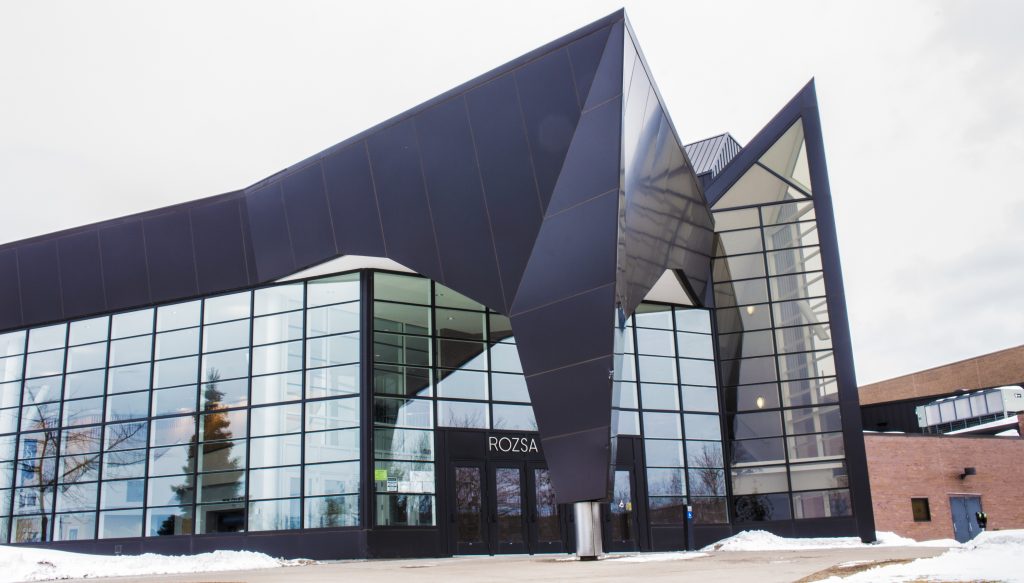The website Clickit Ticket has named Michigan Tech’s Rozsa Center for the Performing Arts among the best 35 university performing arts centers in the United States.
According to Clickit Ticket, the “35 university performing arts centers are the best places in the United States to see dynamic student productions as well as those by world renowned artists. These centers sit at the intersection of passion, profession and learning.”
Among the listed universities are those with high student populations like the University of Minnesota and those with smaller student populations like the Soka University of America.
In describing the Rozsa Center, Clickit Ticket stated, “If your haunt is the Western Upper Peninsula, you probably already know about the fabulous Rozsa Center for the Performing Arts. This awe-inspiring facility schedules performances by both national and university performers in the mediums of dance, theater, music and film. This 80,000 square-foot facility might be the toughest building on our list. Its roof can hold 450 pounds of snow per square foot.”
In an interview with the Lode, Bethany Jones, the marketing manager of the Rozsa Center said, “It is always flattering to see kind words about this place where I work. I believe we have a beautiful venue and both present and produce the highest quality events possible, given our remote location and relatively modest resources compared with larger universities in bigger metropolitan areas. It is wonderful to be recognized for our effort.” She also said, however, that she does not know the explicit criteria that Clickit Ticket used for their survey. “I don’t know much about the comparison and what the criteria for their list was, or how the list was developed and ranked. I’d be curious what the other venues both on and not on the list feel about this ranking. It was created by an online ticket seller, that resells event tickets. I’m not sure what relationship they have to university performing arts venues. We only sell tickets directly to consumers here at Michigan Tech, and do not do business with secondary market ticket sellers like ClickitTicket.com,” Jones stated.
Jones hopes that this honor “gives everyone more of a sense of pride in their work at this venue. Again, it is always nice to see compliments about this place where I devote so much of my time and energy, I’m sure everyone else here feels the same.” She said there are already plans to improve the center and make it more visible in the performing arts landscape.
“From the Planning and Development Director’s (Mary Jennings) job to book and schedule the best possible mix of events, to my job as marketing manager to maximize visibility and PR, to the Production Manager’s (George Hommowun) work to ensure every event happens with the highest level of technical expertise, we all work to achieve a high standard of excellence in our work, every day, for every event. We are currently launching our 2018-19 arts season. Season ticket sales go on sale May 1. With a new season full of fun, lighthearted and plain over-the-top spectacular events, we hope this will be our most successful year yet.”
Commenting on some of the current challenges of the center, Jones said, “Our remote location, limited population base and relatively modest funding sources are all challenges. We also exist as part of a performing arts department on a STEM campus. Arts are not always considered a central focus of the Michigan Tech experience.”
“But we believe absolutely that the arts improve the lives and experiences of everyone who joins us for events in the Rozsa Center. We are creative and strategic in how we maximize our resources every day to make as great an impact with our audiences as we can. From booking events that appeal to families, to collaborating with campus interest groups to bring speakers and performances to Michigan Tech that fit a particularly relevant niche, we do our best to engage audiences and grow attendance at all our events,” Jones concluded.
The Rozsa was constructed when Curtis J. Tompkins was the president of Michigan Tech (1991-2004). The building’s architecture is a representation of a vertical mine shaft, relating it to the Upper Peninsula copper mining history.





